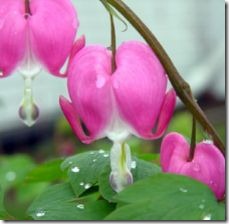Bleeding heart (Dicentra spectabilis) is a charming perennial plant with pink and white heart-shaped blooms that dangle from arched stems. Although bleeding heart looks delicate, the plant is a sturdy, cold-tolerant bloomer appropriate for planting in U.S. Department of Agriculture hardiness zones 2 to 9. Bleeding heart is a good candidate for container planting.
Container
-
As a general rule of thumb, containers should be 1/3 to 1/2 the expected size of the perennial at maturity. Bleeding heart grows to about 30 inches, so a container with a height of at least 10 to 15 inches is appropriate. A smaller container is top heavy and in danger of tipping, and a larger container looks out of proportion to the plant. The type of container is a matter of choice. Plastic is inexpensive but not durable. Clay containers are sturdy and provide good air circulation to the roots, but the soil dries out faster. Ceramic containers are sturdy but prone to breakage during freezing weather. Any container you use must have a drainage hole.
Planting Bleeding Heart
-
Plant your bleeding heart in any lightweight, well-drained potting mixture. Most commercial potting soils are fine, although a handful of sand or perlite improves drainage. Avoid regular dirt from your garden, as dirt becomes heavy and compacted and the roots of your bleeding heart won’t absorb water. To plant your bleeding heart, dig a hole with a trowel, then place the plant in the hole at the same depth it was planted in the nursery container. Pat potting soil firmly around the roots, then water thoroughly.
General Care
-
Bleeding heart is a woodland plant that blooms best in partial shade. Avoid placing your bleeding sun in afternoon sunlight, which is too intense. Check the soil daily during warm, dry weather, as the soil in containers dries quickly. Water your bleeding heart whenever the soil feels slightly dry. Although bleeding heart prefers moist soil, excessively soggy soil may cause the roots to rot. Bleeding heart benefits from a slow-release liquid or granular fertilizer applied early every spring. Apply the fertilizer according to the specifications on the container.
Winterizing
-
Although bleeding heart is a cold-tolerant plant, the roots of containerized bleeding heart have very little protection from the elements. If you have space in your garden, dig a hole in a protected spot, then bury the entire pot in the hole. Cover the pot with several inches of straw or leaves. If you don’t have garden space, place the container in a unheated shed or garage where the temperature will be cool but just above freezing. Give your bleeding heart a small drink of water periodically to keep the soil from becoming completely dry.


Deprecated: strpos(): Passing null to parameter #1 ($haystack) of type string is deprecated in /home/agriviek8Qv/agriviet.net/public_html/wp-includes/comment-template.php on line 2522